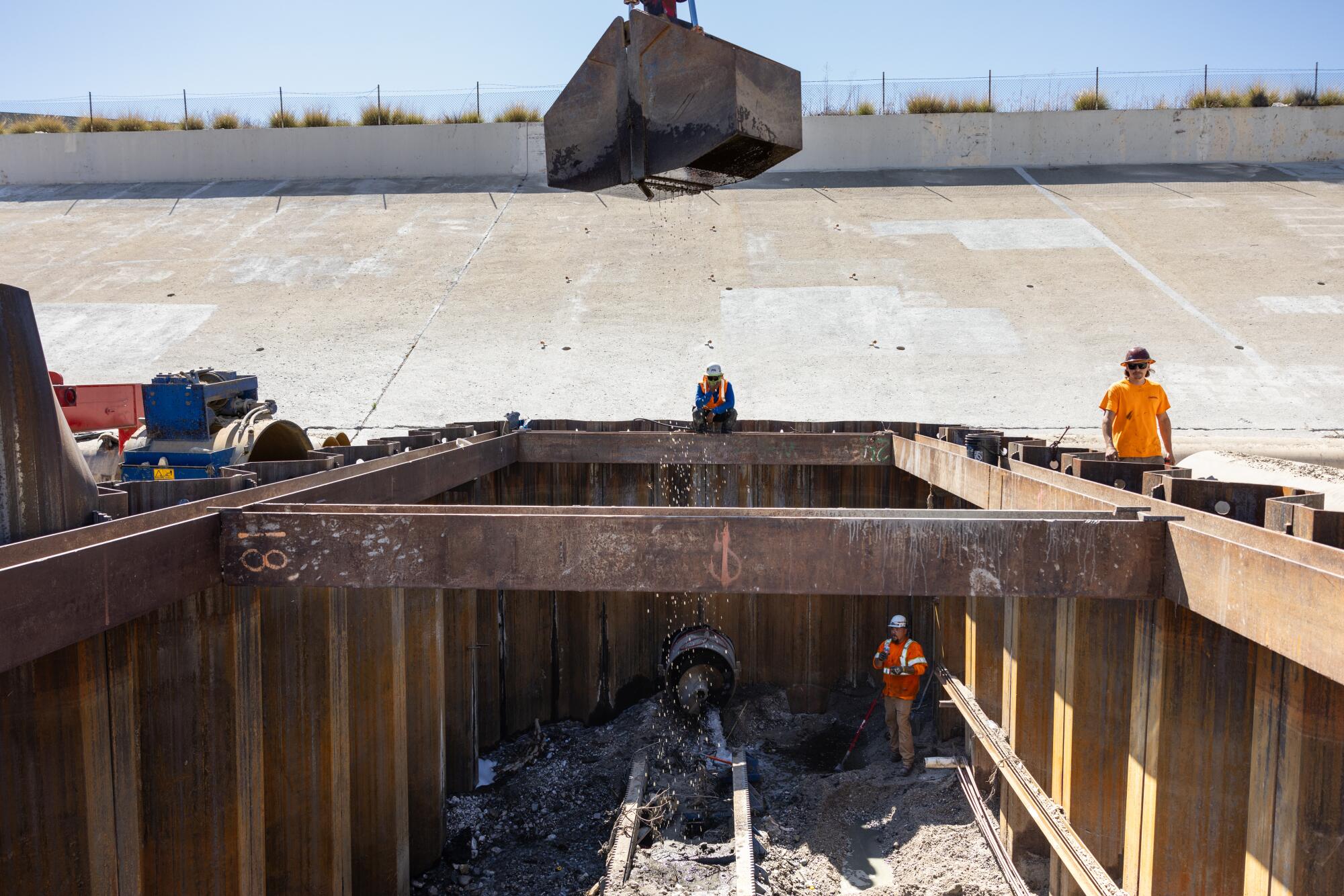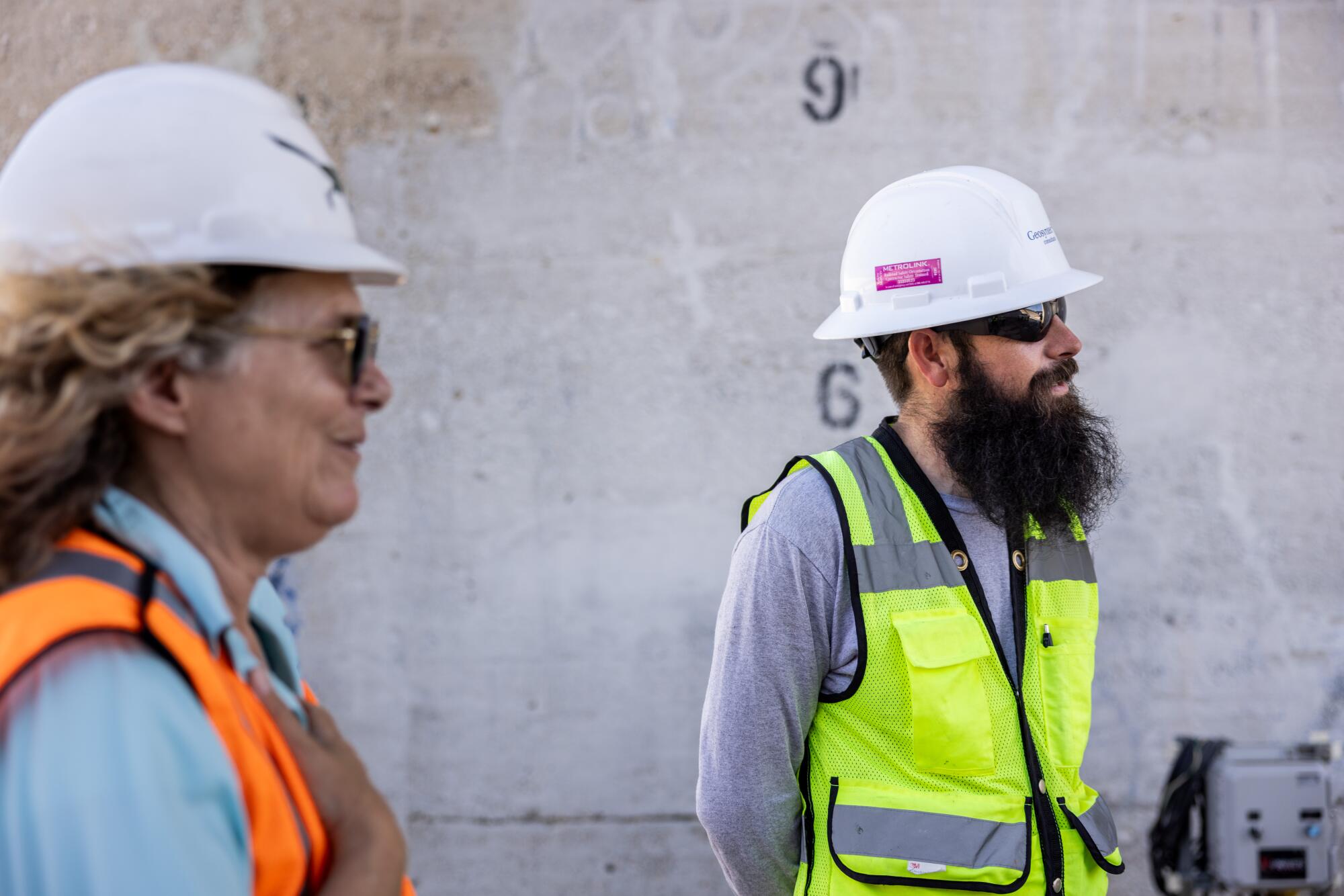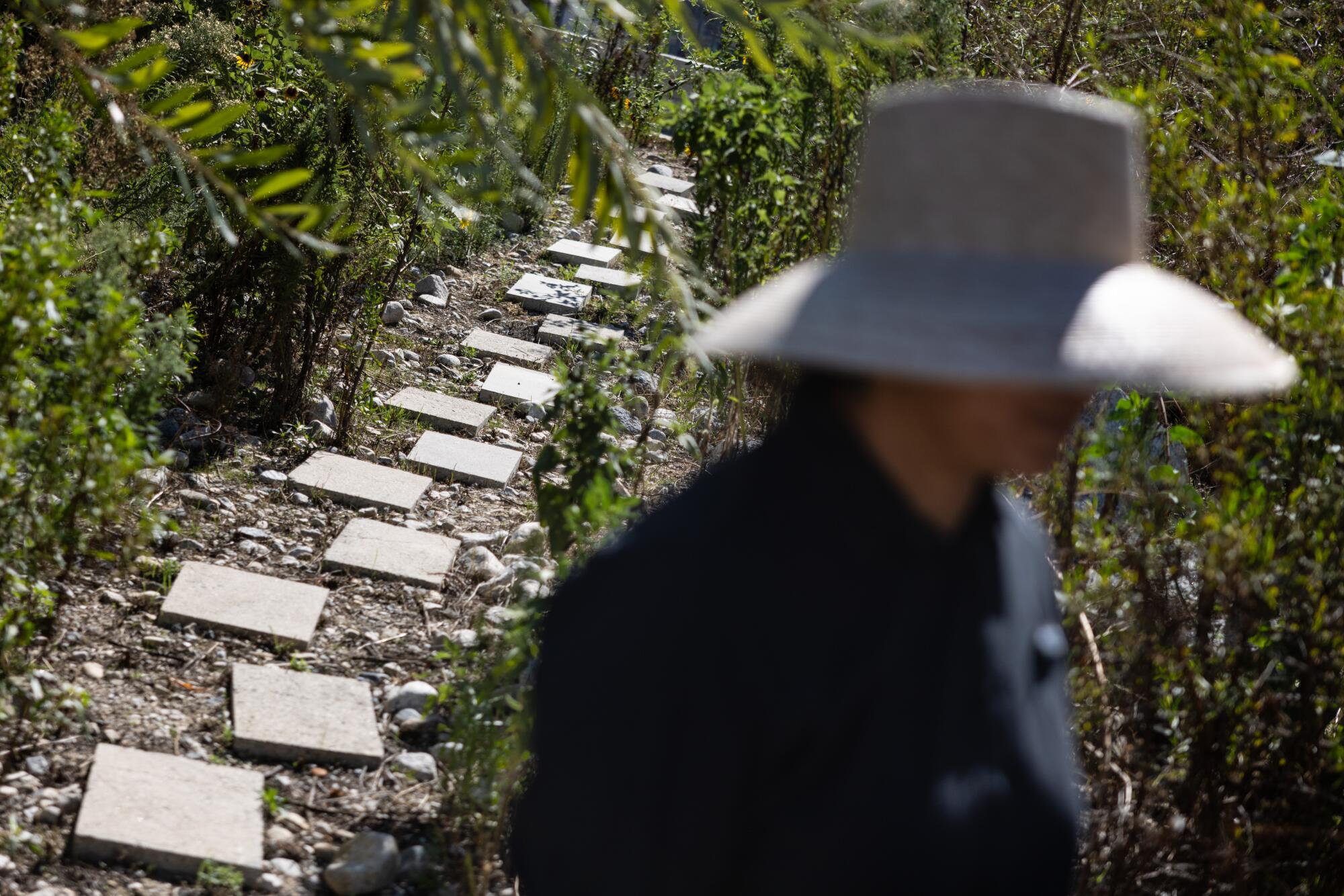
- Share via
For more than a dozen years, Lauren Bon has been creating an artwork so vast, it has required moving many tons of earth. Yet when the first phase of her project wraps up this week, it will be largely invisible. In fact, the clearest evidence of “Bending the River,” as the piece is called, will be a small grate in the concrete bed of the Los Angeles River in downtown. She and her team at Metabolic Studio, the not-for-profit art and research hub she founded and directs, have dubbed it “the great grate.”
Moving the earth for “Bending the River” wasn’t nearly as difficult as moving often intractable bureaucracies — more than two dozen of them — including federal, state and municipal agencies such as the U.S. Army Corps of Engineers, the California State Water Resources Control Board and the Los Angeles Department of Water and Power. That’s because Bon’s project is no simple art installation. Instead, once complete, it will do something unprecedented: draw water from the Los Angeles River and channel it to a well on a property owned by Metabolic Studio on the western banks of the river. From there, it will be filtered, cleaned and delivered to Los Angeles State Historic Park, across the street, for irrigation.
In the process of making it happen, Bon has become the only individual to obtain a legal permit to divert water from the river in more than a century. That permit mandates “beneficial use” — in this case, irrigating the park. (In other words, she can’t turn around and water her lawn with it.)
The project marks a departure from L.A.’s more typical approach to its beleaguered river, which has generally consisted of grandiose feats of engineering and even more grandiose master plans. “Bending the River” is instead more akin to acupuncture — a jab that will loosen a tiny piece of the waterway from its concrete straitjacket so that it might do what nature intended: Water the land.

“It’s not a huge amount of water, but it’s meaningful,” says Martin Adams, general manager and chief engineer at DWP. The project will not only offset the need to import water to irrigate the park, it will clean and recycle polluted water that would otherwise be flushed out to sea. “If you look at all of the storm water capture projects, the bigger ones, they’re all up in the San Fernando Valley, so anything that goes into the river below them has no hope of getting captured.”
Bon says she is working to repair a long-festering injury both geological and psychic. “When we have no connection to the story of water and this place where we live,” she asks, “how do we connect the place to water?”
On track to be completed by mid-October is a 300-foot stretch of clay pipe that will connect the low-flow channel at the center of the riverbed to the well on Metabolic Studio’s Spring Street property. The well has been excavated but will remain in a raw state; the final design around its cap is to be determined.
Artist envisions water wheel transforming a stretch of L.A. River
Against the 51-mile length of the river, “Bending the River” is a small undertaking. For an artist, however, whose work has straddled installation, performance and photography, it is major. Construction on the first phase has cost in the neighborhood of $9 million. Metabolic is part of the Annenberg Foundation, of which Bon is a vice president and director — meaning she knows a few things about navigating L.A. bureacracy. (Her mother is philanthropist Wallis Annenberg.) The foundation funds other projects at the intersection of infrastructure and ecology, including a wildlife crossing over the 101 freeway in Agoura Hills, currently under construction.
For now, all the labor and money poured into “Bending the River” remains largely out of sight. “We built infrastructure,” says Bon, seated amid models and renderings in her studio. “It’s very real, but it will literally be under concrete.”
As for the great grate, it will be a run-of-the-mill industrial drainage fixture: The Army Corps of Engineers, which operates and maintains the river’s concrete jacket, will not allow a unique design that could become an “attractive nuisance.” (That spectacularly named legal concept describes something of great appeal that could generate safety risks.)
“As an object maker, the fact that the grate is it,” Bon says, “that’s humbling.”


Late in August, as downtown temperatures simmered in the high 80s, Bon took me and Times photographer Jay L. Clendenin into the L.A. River to have a look at construction. (Members of Metabolic Studio have been leading regular tours of the site, which will run through Oct. 12.)
Days ahead of our visit, Tropical Storm Hilary had plowed through the area, forcing crews to hurriedly extract equipment from the riverbed and prepare the site for the inevitable torrent. Everything had survived largely unscathed — though the force of the water bent steel beams that braced the dig area and deposited soil and other detritus into the trench holding the pipe. Nearby sat a wild tangle of shopping carts resembling an improvised junk sculpture. (Bon joked about sending them off to a blue-chip gallery as a readymade.) Golf balls, likely from the courses in Griffith Park just upriver, were everywhere.
Golf ball pollution, it turns out, is a very real environmental problem. So is every other type of pollution: the L.A. River at this phase of its life is a soup of treated wastewater, surface runoff and garbage. “Our water is to water like Velveeta is to cheese,” says Bon. “We’re taking water from the Glendale treatment plant with the E. coli of the Arroyo Seco and mixing that with the water from Dodger Stadium.”
How exactly they will clean that water is something the team is just beginning to work on. On the day we visit, workers in Tyvek suits are inside one of Metabolic’s warehouse spaces, layering plants and other organic matter that might leech pollutants out of the water. Sheathed in plastic and penetrated by skylights, the space has a distinctly “X-Files” vibe.
An exhibit at Track 16, ‘Confluence,’ by nine mixed media artists, explores a range of water issues from communities fighting for survival, water scarcity resulting from infrastructure and climate change.
Naturally, since this is an art project, there is an aesthetic component.
The concrete slabs that were cut out of the river’s bed in order to lay the pipe have been trimmed into triangles and arranged in architectonic stacks in one room of the studio. In a separate, cavernous space, large mounds of earth displaced by the digging materialize like a massive earthwork. Milli Macen-Moore, a researcher on the Metabolic team, points out a small California bush sunflower, a native plant, sprouting from one of the piles — a sign of life from soil that has been buried under concrete since the river was paved in 1938.
“The idea that we have a seedbed under the 51 miles of the concrete of the L.A. River,” says Bon, “is a powerful imaginary for ecological regeneration.”
Already, seeds unearthed by the digging have been collected and spread at another property on the eastern banks of the river, a place the Metabolic team refers to as “Undevelopment One.” Bon acquired the property, once a tow yard, in 2015 and began removing pieces of tarmac and seeding the soil with native plants irrigated with captured rainwater. On our post-Hilary visit, it is a riot of life, with bumblebees buzzing around blooming amaranth and apricot mallow.
Levi Walden of Geosyntec Consultants, who is serving as construction manager for “Bending the River,” says he has worked on a lot of underground utility projects over the years. But “nothing,” he says, “quite like this.”


Bon is not the first artist to engage the river (or its tributaries) as subject or site.
Over a century, L.A.’s arroyos have drawn graffitists and their chroniclers — hobo, cholo and otherwise. In the 1970s, Judy Baca brought together a crew of painters to create “The Great Wall of Los Angeles,” a half-mile-long series of murals in the Tujunga Flood Control Channel. More recently, artist Debra Scacco, whose cartographic pieces explore the L.A. River and its landscape, organized a group show at Track 16 gallery inspired by riverine themes. Late this month, a group of artists and cultural leaders, including members of the Tongva and Chumash communities, will stage a festival titled “Procession” that will include a walk tracing the river’s historic courses.
Artist Audrey Chan’s handmade kites will anchor Clockshop’s second kite festival, which celebrates diverse cultural histories and access to public land.
The multidisciplinary arts group Clockshop also has important connections to the river: Its offices lie on the western banks, in Frogtown, and for years it has staged cultural programming at the Bowtie Parcel, an 18-acre strip of industrial land on the eastern banks that is now being converted into a state park (thanks in part to Clockshop’s advocacy). Late last month, the organization launched a three-year multimedia project, “Take Me to Your River,” consisting of oral histories, public storytelling events and a video documentary.
While the city has long turned its back on the river, says Clockshop executive director Sue Bell Yank, for generations of people it has functioned as unofficial public space and improvised backyard. “Children who grew up in the neighborhood would access it and have strong feelings about it,” she says. “It’s this resource.”


For Bon, ecology has always been a critical factor.
In 2005, the artist planted a cornfield — a work she coyly titled “Not a Cornfield” — in the abandoned railyard that now harbors Los Angeles State Historic Park. The piece helped remediate a polluted site and offered the surreal vision of downtown emerging from behind tidy furrows of corn. (It recalled the field of wheat planted by artist Agnes Denes on landfill in Lower Manhattan in 1982.)
Eight years later, Bon staged “100 Mules Walking the Los Angeles Aqueduct,” in which she and members of the Metabolic team, along with a crew of wranglers from the McGee Creek Pack Station, traced the entire 240-mile length of the aqueduct from the Owens Valley to L.A.
It’s fresh, but is it art? Some say the concept is over their heads -- as the growing stalks of largely inedible kernels soon will be.
For all her work with the soil, Bon says she doesn’t place herself in the tradition of land artists, rearranging earth into a spiral like Robert Smithson or creating a desert megasculpture à la Michael Heizer. “I have so much respect for some of these artists’ journeys,” she says. “But I feel my trajectory has been to make reparation rather than make monuments.”
She sees herself more as interventionist and choreographer.
The artist, 61, studied dance as an undergraduate at Princeton University and once apprenticed with Martha Graham (“very intense, very private and deeply collaborative”). As a graduate student at the Massachusetts Institute of Technology (she has a master’s degree in architecture), Bon was influenced by Fluxus artists such as Nam June Paik and Charlotte Moorman, who were jabbing at the boundaries between subject areas at the school’s Center for Advanced Visual Studies, renowned for its mix of scientists and artistic avant-garde. “There was a sense of an expanded field,” says Bon, “that I think ‘Bending the River’ is a part of.
“At a choreographic level,” she explains, “it’s about thinking about the water as a character in a long history of place that wants to be repositioned.”

It was “Not a Cornfield” that led directly to “Bending the River.” Since the corn was not intended to be consumed, Bon had assumed she would simply irrigate her project with runoff from the L.A. River — until she was informed it was against the law to draw its water without a permit. That experience got her thinking about the river’s relationship to the land around it.
“The L.A. River and the state park, they look like they should be connected,” says Bon. “They are literally right next to each other.” But a century of engineering has broken that connection. By “bending” the river back into the city, Bon hopes to link them once again.
For a time, her concept included a water wheel that would draw the water up to the level of the park. But she ultimately scrapped that idea over concerns about maintenance and the introduction of an object that took away the focus from what truly mattered: water and land.
The Solar Futures House was quickly raised using 3-D printing technology and is highly efficient. It recycles water and is powered entirely by the sun’s rays.
“Bending the River” is a work of environmental engineering. It is also a work of art — and by presenting it as such, Bon has made hidebound government agencies perhaps more amenable to experimentation than they might have been otherwise. “I can intervene in bureaucracies as an outsider,” she says. “I’m not a problem-maker internally, I’m a problem-maker externally. And the problem isn’t seen as a problem if it’s seen as a short-term speculative inquiry.”
An artist like Bon, says Deborah Weintraub, chief deputy engineer at the Bureau of Engineering, can bring a fresh angle to water policies that audiences might not otherwise be considering. Her work, she says, “is making the invisible visible.”
Part of what remains invisible — in addition to the 300 feet of clay pipe installed by Metabolic Studio — is the original riverbed.
When the crews from Geosyntec began to remove slabs of the concrete, what was revealed underneath was a flow of fresh water and the seed-bearing soil that had sat untouched since 1938. Despite our best efforts to bury her, nature continues her flow.
“It’s extraordinary,” says Bon. “Life is that strong and that powerful. It is so hopeful.”
More to Read
The biggest entertainment stories
Get our big stories about Hollywood, film, television, music, arts, culture and more right in your inbox as soon as they publish.
You may occasionally receive promotional content from the Los Angeles Times.














